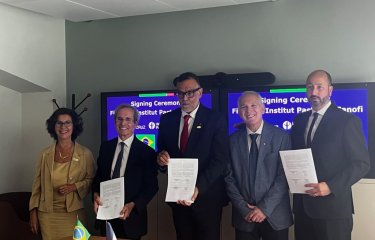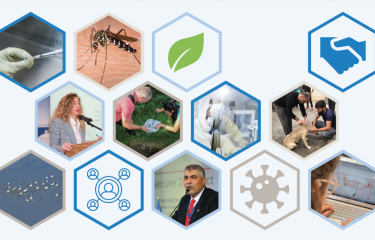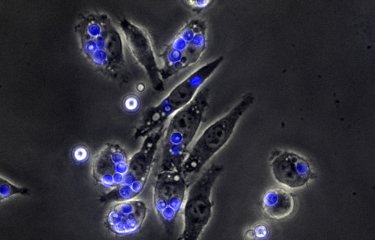Zika virus (ZIKV) is a flavivirus transmitted to humans by Aedes mosquitoes. ZIKV is divided into two phylogenetic lineages: African and Asian. In New Caledonia, the complex interactions between humans, mosquitoes and the virus led to a important outbreak in 2014.
In 2013, the Zika virus emerged in French Polynesia and more than 1,500 cases were identified the following year in New Caledonia. Owing to the emergence of this outbreak, researchers from the Institut Pasteur de Nouvelle-Calédonie have tried to understand why the Zika virus caused epidemics in the Pacific while it circulated on a low level in Africa and in Asia. The team led by Dr. Myrielle Dupont-Rouzeyrol’s started to focus on the molecular evolution of ZIKV’s strains in the Pacific (Dupont-Rouzeyrol and al, 2017, EMI) and, in relation with this genetic evolution, on the vector competence (vector capacity to multiply and transmit the virus to an host) of the local Caledonian vector : Aedes aegypti.
The researchers then measured the vector competence of Aedes aegypti for seven strains of ZIKV belonging to both lineages. They demonstrated that Aedes aegypti from New Caledonia can be infected, and then replicate and transmit ZIKV from both lineages. However, the geographical distribution of the viral lineage influences the vector competence. Regarding Asian ZIKV, the vector is poorly competent (transmission efficiency <10%). But most importantly, no significant difference was noticed in the vector's competence according to the sampling date and the collection site of the Asian ZIKV strains (New Caledonia, French Guiana).
Conversely, regarding the African ZIKV lineage, the capacity of Aedes mosquitoes to transmit ZIKV is significantly greater for older viral isolates (transmission efficiency greater than 37%) than recent isolates (transmission efficiency 10%).
This work, generated as part of an ACIP coordinated by the Institut Pasteur de Nouvelle-Calédonie together with the Institut Pasteur de Dakar, the Institut Pasteur in Paris, the Institut Pasteur du Cambodge and the Institut Pasteur du Laos, stresses the importance of studying the interaction between vectors and their arboviruses according to each geographical context. This approach will improve the understanding of arboviruses’ transmission to prevent their occurrence and improve the monitoring of these outbreaks.
Source
Differential transmission of Asian and African Zika virus lineages by Aedes aegypti from New Caledonia, Emerging Infectious Diseases, 2018
Calvez E1, O'Connor O1, Pol M2, Rousset D3, Faye O4, Richard V5, Tarantola A6, Dupont-Rouzeyrol M7
1Institut Pasteur de Nouvelle-Calédonie, URE-Dengue et autres Arboviroses, Réseau International des Institut Pasteur, Nouméa, New Caledonia
2Institut Pasteur de Nouvelle-Calédonie, URE-Entomologie Médicale, Institut Pasteur de Nouvelle-Calédonie, Réseau International des Institut Pasteur, Noumea, New Caledonia
3Institut Pasteur de la Guyane, Laboratoire de Virologie, Centre National de Référence des arbovirus, Réseau International des Institut Pasteur, Cayenne, French Guiana
4Institut Pasteur de Dakar, Unité Arbovirus et Virus des Fièvres Hémorragiques, Réseau International des Institut Pasteur, Dakar, Senegal
5Institut Pasteur de Nouvelle-Calédonie, Direction, Réseau International des Institut Pasteur, Nouméa, New Caledonia
6Institut Pasteur de Nouvelle-Calédonie, Unité Epidémiologie, Réseau International des Institut Pasteur, Nouméa, New Caledonia
7Institut Pasteur de Nouvelle-Calédonie, URE-Dengue et autres Arboviroses, Réseau International des Institut Pasteur, Nouméa, New Caledonia





